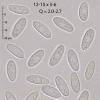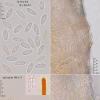
21-12-2025 09:32
Hello.A tiny ascomycete found embedded in wood in

21-12-2025 21:32
Pol DebaenstHello, Garden, Burgweg 19, Veurne, BelgiumOn 10/1

22-12-2025 23:38
Patrice TANCHAUDBonsoir, récolte sur un mur en pierre, apothéci

22-12-2025 00:47
Patrice TANCHAUDBonsoir, récolte à proximité du milieu dunaire

21-12-2025 21:40
Isabelle CharissouBonjour, j'aimerais connaitre les références de

21-12-2025 21:31
Pol DebaenstHello, Garden, Burgweg 19, Veurne, BelgiumOn 10/1

21-12-2025 21:31
Pol DebaenstHello, Garden, Burgweg 19, Veurne, BelgiumOn 10/1

20-12-2025 23:08
Patrice TANCHAUDBonsoir, récolte sur sol sablonneux dans l'arri�
Hi again
Could you help me with this yellow, long stipitate, Hymenoscyphus growing in a peat bog, on Rumex sp. old stems at 1700 m of altitude? Spores allipsoid with very low oily content. Asci up to 140 x 11, IKI b of the Hymenoscyphus-type, 8-spored, arising from croziers. Paraphyses with yellow, multiguttulate VBs. Excipulum with no globulosa or angularis tissue.
I don't find any species that fits well with this collection
Thanks again

Did you look at the two left fruitbodies, are they senescent or do they contain conidia? (to be sure that it is no Symphyosirinia).



